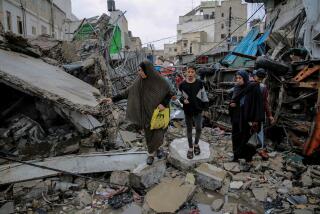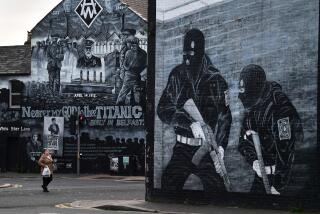Rebellion, Ice Cream, Communion : Truce Edges Sri Lanka Life Toward Normal
- Share via
JAFFNA, Sri Lanka — A brief gunfight in Mannar, 50 miles south of here, Monday shattered a week-old cease-fire between government forces and Tamil separatist guerrillas, government sources said.
However, the fragile truce held here in Jaffna, the principal Tamil city, situated at the northern tip of this Indian Ocean island nation. Jaffna was visited by reporters this weekend after several months during which it was virtually cut off from the rest of the island.
Tamil guerrilla groups remained visible, posting propaganda tracts and patrolling, but there were no reports of shooting in the entire Jaffna Peninsula, where 1 million Tamils live.
Government troops stayed in their garrisons, not even venturing into town for supplies. From a 300-year-old Dutch fort, soldiers behind heavy sandbag walls calmly watched a college cricket tournament below.
For the first time in at least six months, the streets of Jaffna were alive with shoppers, and an ice cream truck patrolled the neighborhoods, rather than army jeeps. In the city’s large Roman Catholic areas, young girls who had been waiting weeks for the violence to ebb put on crisp white dresses for first communion.
And for only the second time in three months, the daily train from Sri Lanka’s capital of Colombo arrived, laden with Tamils long separated from their families.
Violence Elsewhere
While Jaffna was peaceful and showing signs of vitality after a long siege, gunfire between soldiers and an unnamed guerrilla group erupted in Mannar, another peninsula on the northern part of the island, at a point closest to India.
Government sources in Colombo told Reuters news agency on Monday that 15 Sri Lankan soldiers, taking an ailing soldier to the main hospital in Mannar city, were attacked by several guerrillas who opened fire from a jeep. The sources said the soldiers returned fire, killing one guerrilla, possibly a member of one of the 30 or so independent rebel groups not party to the truce achieved last week in the decade-old conflict here.
Especially in the last year, this balmy island nation once known as Ceylon has been a crossfire of violence. The strife pits Tamil separatists, who are seeking to create an independent homeland here in the north, against the often brutal and undisciplined Sri Lanka government forces, most of them Sinhalese--the nation’s ethnic majority. Since July, 1983, more than 1,000 people have died in the conflict.
“We have gone through a terrible period,” said M. Panchalingam, a Tamil who is government agent for Jaffna. “One the one side, we had the armed forces. On the other side, we had the terrorists. In between the two were the normal people.”
Signs of the city’s extreme isolation and devastating violence are quickly obvious. The reporters were the first guests at the city’s largest hotel in three months. The two-lane road leading up the peninsula to Jaffna was pitted with bomb craters. Burned frames of army vehicles litter the road shoulders.
In town, the municipal building and police headquarters have been destroyed by guerrilla bombings. Nearby are the ashes of what was the Regal Cinema.
Even the few signs of normalcy are only tentative steps on the part of the battle-weary populace, nothing like the “festive air” described in government-controlled publications.
Until the cease-fire was reached last week between the largest guerrilla organizations and the government, the Jaffna Peninsula, connected to the body of Sri Lanka by a narrow neck of land called Elephant Pass, was all but cut off from the rest of the island.
Fishermen Hampered
During the last six months, the estimated 100,000 fisherman here were prohibited even from untying their boats as the Sri Lanka navy attempted to stop guerrilla traffic from India, 25 miles away across the Palk Strait.
Since the cease-fire, the government has relaxed fishing rules, allowing boats to go as close as three miles offshore during daylight. But the boatmen complain that good fishing is at least 15 miles out and only at night--a prohibited time under the 8 p.m.-to-4 a.m. curfew still in effect.
Despite the curfew, the army has ruled the streets of Jaffna, the largest Tamil city, only during the day. “Every day I would be worrying,” Panchalingam said. “The army would be coming in town and the shops closing and the people running. You can’t imagine it unless you experience it.”
At night, the streets belong to the guerrillas--the Liberation Tigers of Tamil Eelam, the Tamil Eelam Revolutionary Organization, the People’s Liberation Organization of Tamil Eelam or the Eelam People’s Revolutionary Liberation Front--known collectively here as “the boys.”
‘No Government’
“There is no government in Jaffna district,” said Shunmugam Murugesu, 62, owner of a rice mill and a Jaffna food-supply business. “After 7 at night, the boys rule.”
The truce notwithstanding, there appeared to be much more palpable resentment than a year ago--if not against the rebels, at least against the living conditions created by the conflict.
During the virtual isolation of Jaffna, for example, there has been no gasoline available except through a black market operated by the guerrillas. According to Bishop Deogupillai, the old price for fuel in Jaffna was about $2 a gallon. But now, the guerrillas--”our boys”--have recently been charging people as much as $9 a gallon.
“Prices were soaring, soaring, and then there was always the danger the boys would come and take vehicles,” said Father B. Deogupillai, bishop of Jaffna.
Because of rebel robberies, all bank branches were closed and customers were forced to travel miles out of their way to obtain money in bank rooms maintained at the military headquarters.
One of the government’s rationales in signing the cease-fire is that, after so many months of deprivation, the people of Jaffna will enjoy their renewed freedom and abandon support for the rebels. If the reactions of some residents are a test, the strategy has some chance of working.
Not Getting Any Worse
“At the moment the people are only relieved their conditions are not worsening,” said Bishop Deogupillai. “But at least now, they can go out without fear of being molested or fear of being robbed.”
More to Read
Sign up for Essential California
The most important California stories and recommendations in your inbox every morning.
You may occasionally receive promotional content from the Los Angeles Times.










